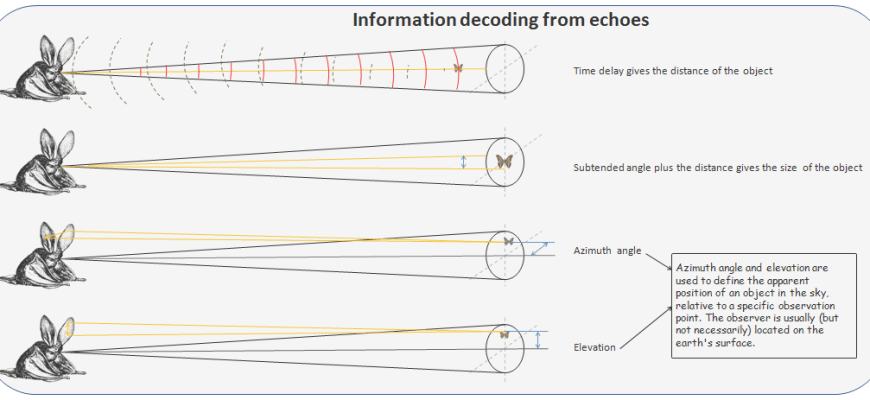Biomimetics!! The name sounds a bit like science fiction doesn’t it!! Well it simply means the application of natural principles in engineering and technical systems. Like most of you would react I was also a bit curious, as of what this study field is about, and how does it work to take something from nature and apply it on a technical system or why look at nature for solutions. Now after having done a master in bionics in energy systems I can at least describe in a few sentences one of my projects during the course.
Though I was still learning the ways of bionics, I was quite excited when I was asked select a role model for principle abstraction and implementation. I opted to do a bottom up approach and selected bats as my focus. Bats are mammals of the order Chiropteran whose forelimbs form webbed wings, making them the only mammals naturally capable of true and sustained flight[1]. Bats can be found almost everywhere in the world apart from extreme climatic conditions like Polar Regions and deserts. Many species of bats live in dark caves but not all of them rely on vision for hunting and moving around but as many as half the species of bats out of some 900 use a trick called echolocation[3]. They use echolocation for traveling, avoiding obstacles and also hunting food. Echolocation simply refers to ultrasonic sound based communication, the bats make a special sound and then compare the outgoing echoes to the returning ones: based on this information their map a detailed image of the bats surroundings[4]. One might think how much information can a bat receive from simple echoes, the answer is enough information to find out whether a object is moving, stationary, direction of movement and also surface roughness or the obstacle this facilitates the bats to detect, localize and even classify their prey in complete darkness. This is demonstrated in the following video where a group of scientists place a metal surface in a dark room and observe if the bats think that it’s water and try to drink from it. This points at the fact that bats might be able to differentiate between different roughness’s of surfaces [video].
In terms of pitch, bats produce echolocation calls with both constant frequencies and varying frequencies. Most bats produce a sequence of calls by combining constant frequencies and varying frequencies. Although low frequency sound travels further than high-frequency sound, calls at higher frequencies give the bats more detailed information–such as size, range, position, speed and direction of a prey’s flight. Thus, these sounds are used more often.

Bats use Low duty cycle echolocation in this type they separate their calls and returning echoes by time. Bats that use this approach to time their short calls and to finish before echoes return. The delay of the returning echoes provides the bat with the ability to estimate range to their prey. This also give information with regards to the direction of an moving object, the pulses of the echoes are shoter then the object is coming towards the bat. In case of the pulses being longer apart from each other then it can be said that the object is moving away from the bat[6].
Bats also employ High duty cycle echolocation here they emit a continuous call and separate pulse and echo in frequency. The ears of these bats are sharply tuned to a specific frequency range and they emit calls outside of this range to avoid self-deafening[5]. Bats are able to communicate using ecolocation in caves where a few thousand bats are living in at single time.
For bats to listen to the echoes of their original emissions and not be temporarily deafened by the intensity of their own calls, the middle ear muscle contracts to separate the three bones there–the milieus, incurs and stapes, or hammer, anvil and stirrup–and reduce the hearing sensitivity. This contraction occurs about 6 ms before the larynx muscles begin to contract. The middle ear muscle relaxes 2 to 8 ms later. At this point, the ear is ready to receive the echo of an insect one meter away, which takes only 6 ms.
This knowledge can be used for designing devices for the hearing impaired, where a detailed description of the surrounding can be provided to the user to help him aware of whats arround the user. Though devices which warn the user of an obstacle exist, but much information can be provided by implementing the principles abstracted from bats. Echolocation is already being used for under water communication and detecting large objects under water. Another probable use for echolocation is for automobile industry where many accidents can be avoided if echolocation is used for making the driver aware of obstacles in case of low visibility conditions.
LITERATURE
- Scientific American How do bats echolocate and how are they adapted to this activity
- Bat echolocation calls: adaptation and convergent evolution Gareth Jones and Marc W Holderied Proc. R. Soc. B 2007 274, doi: 10.1098/rspb.2006.0200, published 7 April 2007
- Echolocation in bats Matti Arias HUT, Laboratory of Acoustics and Audio Signal Processing
- According to a new scientific study, it would appear that the human brain is in the habit of processing visual and audio information in similar manners, as in it uses the same type of “encryption” for both types of information.
- Bat echolocation calls: adaptation and convergent evolution Gareth Jones and Marc W Holderied.
- Directional sensitivity of echolocation in the horseshoe bat, Rhinolophus ferrumequinum H. -U. Schnitzler, A. D. Grinnell.
- Figure: Bat Image-Nature kids Jeunesse, Magazine of the new brunswick young naturalists club Issue 24(2011). butterfly image-thesumofallcrafts.blogspot.com; Edited by waseem ahmed.



